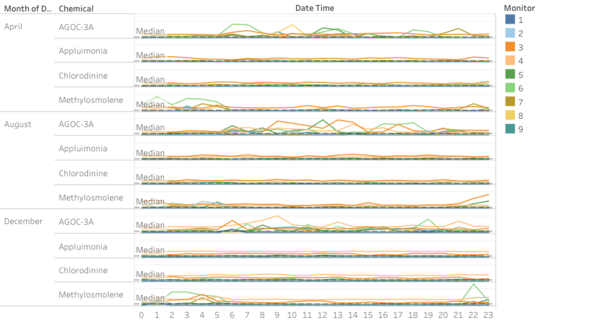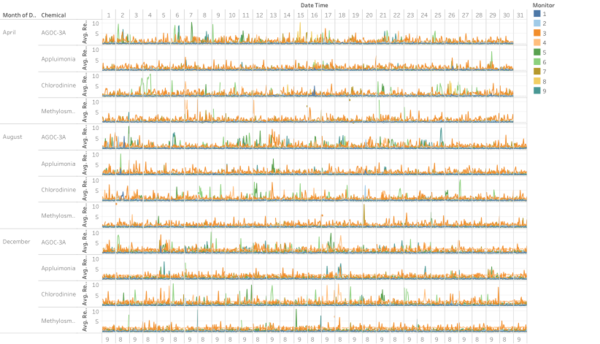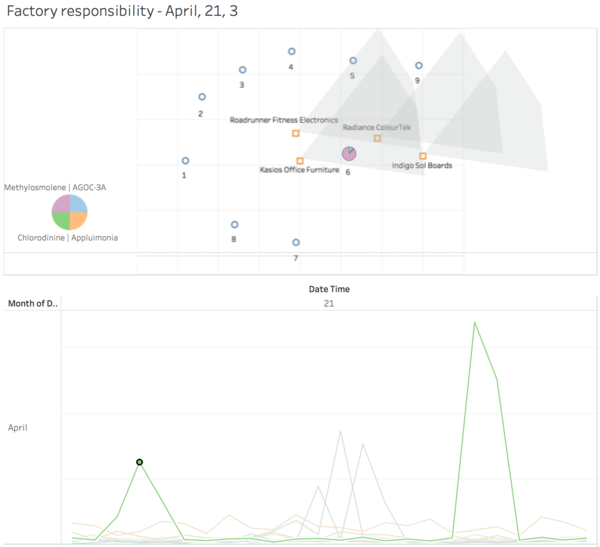Difference between revisions of "ISSS608 2016-17 T3 Assign ZHANG JIAQI"
| Line 71: | Line 71: | ||
[[File:Zjq19.png|600px]] | [[File:Zjq19.png|600px]] | ||
| + | |||
| + | ==Feedback== | ||
| + | |||
| + | ===Feedback by Xintian=== | ||
| + | |||
| + | Hi Jiaqi, | ||
| + | |||
| + | After reviewing your report, here are some my comments: | ||
| + | |||
| + | 1) In terms of wind visualization, the zoom-in and zoom-out function can be much better and clearer. | ||
| + | |||
| + | 2) A reference line is needed in the line chart. | ||
| + | |||
| + | Regards, | ||
| + | |||
| + | Xintian | ||
Revision as of 11:50, 13 July 2017
Contents
Mini Challenge 2
Q1. Sensor performance
Monitor 3 has the most volatile readings which is unexpected. Monitor 1 and 2 are least volatile. Monitor 4 shows an increasing trend. 7 and 8 have normal volatility.

Monitor 4 and 9 show an increasing trend in the reading. This trend can be seen in all four chemicals.
All monitors do not have readings for 0 hour on 2,6 April, 4,7 August, and 2 December. 2 August and 7 December only have readings for certain chemical and certain sensor.
We realized some peaks are caused by double readings in chemical ‘AGOC-3A’, as there is a mistake of recording ‘Methylosmolene’ as ‘AGOC-3A’. Monitor 1 and and 2 do not have double readings in April. Monitor 7 and 8 do not have double readings in August and December.
The pattern of counting ‘AGOC-3A’ twice and ‘Methylosmolene’ 0 time can be seen in all the time marked by the orange points in the picture above.
Q2. Chemicals
‘AGOC-3A’ and ‘Methylosmolene’ are being detected by sensor group in excess amount. Most of the peaks are captures by sensor 6.
We can filter ‘Appluimonia’ and ‘Chlorodinine’ to see their patterns better.
Readings distribution across 9 sensors and 4 chemicals are shown below. There is a growing trend from April to December. Average readings in same month are very similar.
‘AGOC-3A’ has value above median from 5am to around 3pm in August, and until 9pm in December. ‘Methylosmolene’ has opposite pattern during each day. ‘Appluimonia’ and ‘Chlorodinine’ do not show obvious patterns.
Q3. Factories
See overall pattern, and spot extreme values.
Filter readings to smaller range to see small changes. High readings for ‘Appluimonia’ and ‘Chlorodinine’ can be seen in the below graph.
Select month and date to zoom in. Click on hours that are multiple of three to see the wind at that time. Change minutes and degree to see where the chemical can get to.
To determine which factory is responsible for which chemical release, we follow the steps mentioned above. Sensors that show high values and are covered by only one factory and tell us which factory is releasing the high reading chemical. Some sensors are covered by more than one factory. However, by looking at different times, we can more or less know the chemical release of each factory. For example, April 11 3. Sensor 9 detected ‘Methylosmolene’ by Indigo.
Below graph shows ‘Methylosmolene’ released by Kasios. Because sensor 6 shows a spike and sensor 5 shows nothing.
After checking all high readings, we found that Roadrunner Fitness Electronics and Radiance ColourTek are responsible for the release of AGOC-3A and Chlorodinine. Kasios Office Furniture is responsible for the release of Methylosmolene. Indigo Sol Boards is responsible for the release of Methylosmolene and Appluimonia.
Feedback
Feedback by Xintian
Hi Jiaqi,
After reviewing your report, here are some my comments:
1) In terms of wind visualization, the zoom-in and zoom-out function can be much better and clearer.
2) A reference line is needed in the line chart.
Regards,
Xintian
















